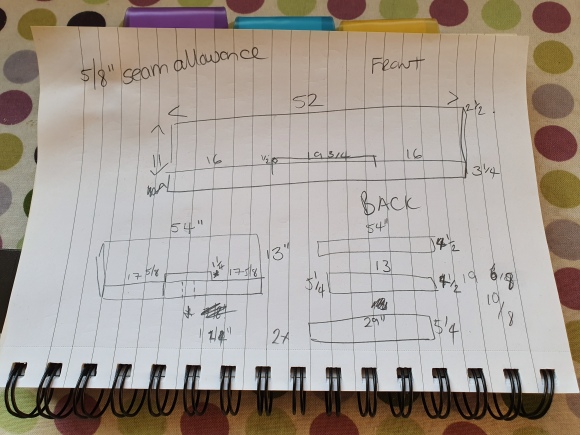A couple of weeks ago, I tried adjusting some t-shirts that were too long for Jez, but it was a bit of a disaster. The t-shirts had been bought before we moved, and since then we have both managed to loose quite a bit of weight. Yay!
Unfortunately, this meant that the shortened t-shirts looked ridiculous. I threw them back in the wardrobe to use the fabric for something else. I’m now considering deconstructing them and rebuilding them in a smaller size, retaining the neck band if I can. But that’s for another day.
Today, I completed my first successful sewing project in a long time, and I only started it yesterday. I had some leftover fabric that I thought would make a good cover for my electric piano. It came from some Ikea curtains I had shortened for my office. Up until now I’ve just been using some cheap yellow and white spotted fabric that I impulse bought years ago to keep the dust off my piano. It often slides off, and is a bit of an eyesore in the music room.
Yesterday, I started taking measurements and working out how to construct the cover. I wanted to create something that would:
- be easy to put on and take off,
- fit around the attached music stand, and
- not slide off.
Here are my doodlings:
I cut out the pattern pieces last night, although I wasn’t entirely sure how I was going to fasten the cover at the back. I thought probably with Velcro, which I would have to order, but I thought I’d wait until I got to that bit to work it out.
This morning I started piecing it all together, and didn’t have any problems. It all went together nicely and fit as I intended.
In the end, after chatting with Jez about it, I decided I would go for a Velcro fastening. I’ve ordered some which should arrive on Monday. In the meantime, the cover still does it’s job and I’ve just pinned it together with some fabric clips for now.
I particularly enjoy constructing covers from object measurements. I’ve had two other examples of this with the Guitar and Bass Amp Covers and the Chair Cover for Cape Beauty, and they came together better than I had expected on both occasions.
It looks like I have the sewing and blogging bug back. Hooray!










 I started with ‘
I started with ‘ After receiving this fabric and needing to pay the extra tax charge, I thought I’d look into UK based alternatives. I tried out ‘
After receiving this fabric and needing to pay the extra tax charge, I thought I’d look into UK based alternatives. I tried out ‘ After my success with his
After my success with his  My boyfriend is an amazing musician who loves the music of the 1960s, as well as many other genres. He has always wanted a Monkee’s shirt, but has never been able to find one. I’ve googled for them and they are really hard to find. There are some hand-made ones available online, but they are very expensive and tend to ship to the US only …so I decided to have a go myself.
My boyfriend is an amazing musician who loves the music of the 1960s, as well as many other genres. He has always wanted a Monkee’s shirt, but has never been able to find one. I’ve googled for them and they are really hard to find. There are some hand-made ones available online, but they are very expensive and tend to ship to the US only …so I decided to have a go myself.
 The fabric I used was a red twill, and the thickness made turning the collar and cuffs out and getting sharp corners quite difficult. When I was creating the button holes on the cuffs I realised that I should have removed more thickness from the seams, as I had quite a bit of trouble getting the automatic buttonhole foot to work correctly due to the fabric bulk. I’ll note that for future and probably use thinner fabric too, although this shirt will be really hard-wearing and last a long time. We were both pleased with the results in the end, but I think I’ll wait a little while before I make another.
The fabric I used was a red twill, and the thickness made turning the collar and cuffs out and getting sharp corners quite difficult. When I was creating the button holes on the cuffs I realised that I should have removed more thickness from the seams, as I had quite a bit of trouble getting the automatic buttonhole foot to work correctly due to the fabric bulk. I’ll note that for future and probably use thinner fabric too, although this shirt will be really hard-wearing and last a long time. We were both pleased with the results in the end, but I think I’ll wait a little while before I make another. Do you remember the
Do you remember the  While I was in the mood for night wear, I decided to try copying a pyjama top that I find very comfy and flattering which was starting to wear out. I had a lovely t-shirt fabric from
While I was in the mood for night wear, I decided to try copying a pyjama top that I find very comfy and flattering which was starting to wear out. I had a lovely t-shirt fabric from